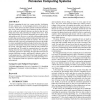Free Online Productivity Tools
i2Speak
i2Symbol
i2OCR
iTex2Img
iWeb2Print
iWeb2Shot
i2Type
iPdf2Split
iPdf2Merge
i2Bopomofo
i2Arabic
i2Style
i2Image
i2PDF
iLatex2Rtf
Sci2ools
117
click to vote
SAC
2009
ACM
2009
ACM
Self-organized control of knowledge generation in pervasive computing systems
Pervasive computing devices (e.g., sensor networks, localization devices, cameras, etc.) are increasingly present in every aspect of our lives. These devices are able to generate enormous amounts of data, from which knowledge about situations and facts occurring in the world can be inferred; inference can also be done by combining data items and generating new (higher-level) ones. Such data and knowledge is of extreme importance for to context-aware and mobile services. However, we are left with the problem that the possibly huge amount of data and knowledge generated can be very hard to be analyzed and made usable in real-time. The core of the problem in today’s pervasive environments lies between the ability to extract meaningful (useful) knowledge from the data while making sure the total amount of data does not become overwhelming to the system. This paper focus on this trade-off using (without loss of generality) the W4 model for contextual data as a case study. Starting from t...
Related Content
| Added | 23 Jul 2010 |
| Updated | 23 Jul 2010 |
| Type | Conference |
| Year | 2009 |
| Where | SAC |
| Authors | Gabriella Castelli, Ronaldo Menezes, Franco Zambonelli |
Comments (0)

